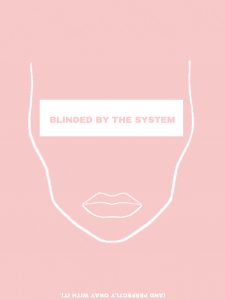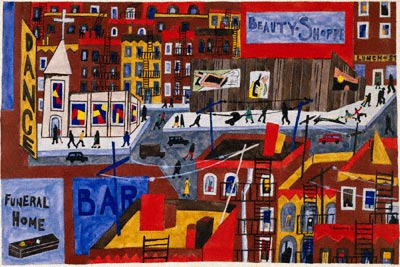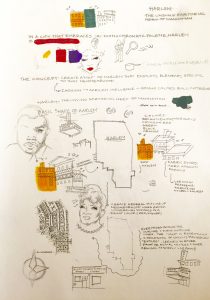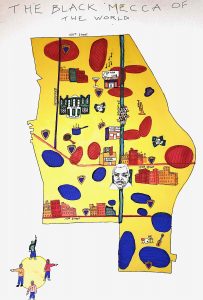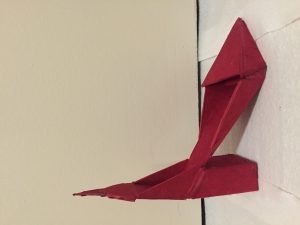TILE OF WORK: CONFESSIONS OF A POTENTIAL NARCISSIST
PROJECT DESCRIPTION:
Student will create a self-portrait based not on physical appearance but on confessions of self. The self-portrait should not be a literal or traditional rendering (i.e. student will not work from a photograph of herself or draw what she sees in the mirror). The self-portrait should not necessarily resemble the artist but should still function as a reflection of the artist.
Any medium may be applied. For the first phase of the bridge project, the student will create ten self portrait renderings that are based on physical appearance, and subsequently manipulate those renderings in some way to either reveal something new about the artist, or to disguise the artist.
The final project should combine elements of the artist’s strengths and weaknesses (in a creative sense, what do you feel you are good at? What are you not so good at? How can you combine strengths and weaknesses to create a powerful and resonant work of art?)
MATERIALS USED:
(Phase one):
Graphite, Micron pen and Tombow marker on sketchbook paper
Liquid eyeliner and acrylic paint on Canson paper
PROJECT REFLECTION:
The fifth and final bridge project for Integrative Studio was intended to be a self-directed project that functioned as an opportunity for students to explore both their strengths and weaknesses as artists/designers and potentially explore something that they did not have the chance to with previous bridge projects.
Throughout high school, I struggled with severe self-image issues. I was a deeply insecure individual in just about every sense. During my senior year, I was assigned several projects in my art major class that dealt with self portraiture. Such projects were extremely stressful and anxiety-inducing for me; the prospect of having to create renderings of myself made me sick to my stomach. For one of the projects, I had to beg my teacher to let me create a portrait of someone other than myself, because I could not stomach the thought of drawing my own face. Since moving to New York, however, I’ve gotten to a point where I simply do not care so much (presumably because I’m in a position where I just can’t care so much). Although I am not completely confident in who I am, I’ve simply learned how to manage my own self-esteem issues. In addition, I’ve established a creative goal for myself — I want to make art that is powerful and resonant. I want to challenge myself to talk about and explore uncomfortable subjects through my work. I want to be candid and honest and a little bit vulnerable. When Mylo gave us the opportunity to come up with our own project, I knew I needed to take advantage of this opportunity — to express my own inner thoughts and vulnerabilities in a work of art is a little bit terrifying, but it can also be extremely cathartic. If I could successfully pull this off, it would be a testament to how much I’ve grown as an artist in the past year.
For phase one, I decided to create ten self-portraits based on my physical appearance. To look at my own reflection and draw what I see is still challenging for me, but it also felt extremely liberating. I had to manipulate these renderings in some way, so some of them offered textual confessions, while others bore stylized features that either explicitly or implicitly expressed an emotion or vulnerability. In comparison to phase two (the final piece for this project), these renderings relied far more on my physical appearance. For my final piece, I wanted it to be less about creating a self portrait that looks just like me, and more about a self portrait that says more about me than any physical features could.
Before delving into the final piece, I had to engage in a lot of sketchbook drafting. I knew I wanted my final portrait to be highly stylized; prior to my time at Parsons, I hadn’t really developed my own artistic style. Most (if not, all) of my work consisted of highly realistic drawings/paintings. I was a perfectionist, so much so that I couldn’t bear the thought of creating something that did not look realistic. Since moving to New York, however, I’ve pushed myself to develop my own distinct artistic style. I still haven’t solidified my style yet, but I figured this project would be a perfect exercise in developing my style. I do a lot of personal writing in my free time, and recently I’ve been exploring the notion of combining my passion for art and writing. Thus, many of my sketchbook pages are filled with drawings and text. I knew I wanted text to be one of the primary design elements of my composition, so I began drafting out “confessions” in the pages of my sketchbook. In my final design, the confessions of self occupy the negative space behind the stylized portrait. Poor planning on my part meant that the content of the text was ultimately compromised (the original confession was much longer, but naturally I ran out of space on my paper), but I am still pleased with the outcome. Not only does the content of the text provide insights into how I feel, but the way it’s formatted on the page makes it as much a design element as the actual portrait. The text is intended to reveal the contradictions of my own perception of self. While I still have not fully embraced my physical appearance, I am very much in love with my own mind. I am in love with my thoughts and ideas — I am not always in love with the execution, but always the ideas. I wonder, then, if this makes me a true narcissist. I cannot look at my own reflection in the mirror when I wash my hands. I love to disassociate — abandon my own body and assume a physical form that is more beautiful than my own. But yet, I am madly in love with what goes on inside my mind. I often wonder if I am in fact a narcissist because I love to talk about myself, to write about my life, and to share my musings with others. All of my work is deeply personal. Is the need to make art that expresses one’s own beliefs or identity the truest form of self-obsession? If you feel that the inner-workings of your mind are important enough to be put down on paper and ultimately shared with the world, doesn’t that make you a little bit narcissistic?
The point of my piece, however, is to not look down on my self for being so in love with what exists beyond my physical appearance. My intent is to address this idea that is presumably relatable to a lot of people (aren’t we all in love with our thoughts… if not, shouldn’t we be?) in hopes that I (and others) can feel empowered by this notion. We are taught to feel shame in loving parts of ourselves (perhaps this is why the most confident people are often feared), but is self-love (in whatever way it manifests) not a good thing? If you can’t love your physical being, should you not at least fall in love with your own ideas (the part of your being that you have some control over)?
PHASE ONE: Ten renderings











